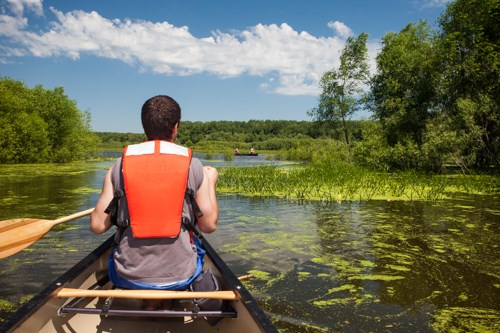
NPS IntroductionThe Vermillion River flows through a 17-by-2.5-mile tract of floodplain forest before it joins the Mississippi River dowstream of Prescott, Wisconsin. It is a classic floodplain forest with meadering, and often dead-end, channels and dotted with islands. This is the place to go for canoeing in near wilderness conditions. The canoeist and kayaker must watch where they are. It's not hard to get lost in the maze of waterways. HistoryAfter the last glaciers melted some 10,000 years ago, a braided-stream system dominated the Mississippi River. In a braided stream, the main channel separates into a number of smaller, interlocking or braided channels. A remnant of that old river system is the Vermillion River Bottoms. The word "Vermillion" is the French translation of the Dakota word WA-SE-SA WA-KPA. The area was so named for the brightly-colored ocher (iron ore used as pigment) that was found in the nearby sandstone. Truly one of the most beautiful and untouched areas of the Mississippi National River and Recreation Area, the Vermillion River Bottoms is a spectacular example of floodplain forest as it must once have been from Itasca to the Gulf of Mexico. In fact, canoeing or kayaking the bottoms, it is easy to be reminded of the bayous at the southern end of the river. There is an absence of houses and roads and an abundance of birds and other wildlife. Occasionally, the boater will pass through a landscape of trees whose roots are submerged for as far as the eye can see. Other times the landscape is characterized by grasses, shrubs and trees thriving just inches above water level. This habitat supports a variety of wildlife, including many hard-to-find birds, fish and mussels. Upstream from its confluence with the Mississippi, the Minnesota Department of Natural Resourses has designated parts of the Vermillion as trout stream. This designation carries with it rules of use that should significantly improve the water quality of the river. As part of an upsurge of interest in the health of the entire watershed, the Friends of the Vermillion River Water Trail are working to expand access to the river by kayak and canoe as well as secure state designation as an official Minnesota Water Trail. ActivitiesBirdwatching, paddlesports, and fishing are the predominant activities in the Vermillion River Bottoms. The fishing will be for mostly catfish and northern pike, but further upstream the anglers pursue trout. Hours, Directions, and Contact Information
Nearby SitesHastings River Flats Park, Jaycees Park, Lake Rebecca Park are all in Hastings, MN. |
Last updated: March 5, 2025
